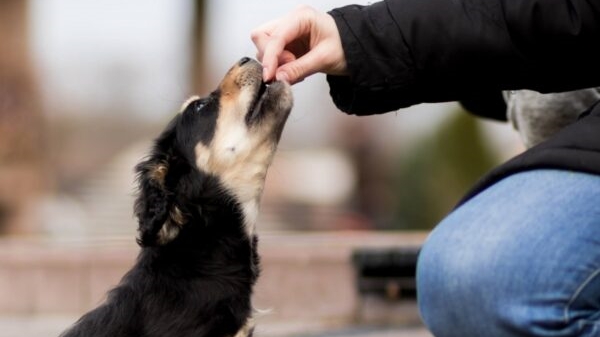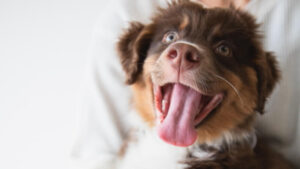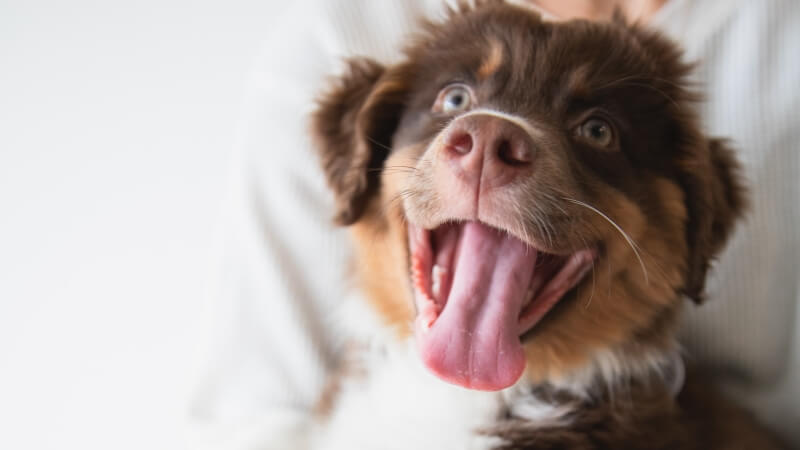
Dog Puzzle Feeder vs Interactive Toys: Which Is Best For Your Pooch?
Choosing the right plaything for your furry friend – be it a dog puzzle feeder or interactive toys – is essential for their mental and

Does your dog gobble up their meals in seconds flat? Do they voraciously devour their food without even stopping to chew?
If your pup is more of an inhaler than a chewer at mealtimes, it may be time to consider slowing down their eating pace. While it may seem harmless, when dogs eat too fast, they miss out on some key benefits of slow feeding.
In this blog, we’ll explore the significance of slow eating for dogs and why it should be encouraged. We’ll look at the many hidden health and behavioral perks it provides.
We’ll also give tips for how to slow your dog’s feeding time to optimize their enjoyment and get the most from their meals. Let’s dive in!
Slow feeding simply means extending mealtimes so your dog eats at a more leisurely pace rather than scarfing down food all at once. This gives them time to properly chew and digest their meals.
Signs your dog is eating too fast include:
Slow feeders aim to transform their rapid eating into a 10-15 minute meal by controlling food access. This pace better matches the natural eating speed of their wild ancestors.
There are numerous advantages when dogs take time to enjoy their food versus rushing through it. Here are some of the top benefits of slow feeding for dogs:
When dogs gulp meals down quickly, their stomachs have trouble keeping up. This can lead to gas, bloating, vomiting, and even a life-threatening condition called gastric dilation volvulus.
Slow eating allows improved chewing and gives the digestive system time to properly release digestive enzymes and process food. This prevents GI upset and discomfort.
Bolting food causes dogs to swallow more air along with kibble, which can dehydrate them. Slow eaters are better able to consume and absorb water with meals. This helps them stay hydrated and aids food breakdown.
Inhaling food quickly means dogs don’t chew kibble thoroughly and are prone to choking. Slowing down intake lets dogs actually chew food, lowering aspiration and choking hazards. This helps prevent scary emergencies and even potential asphyxiation.
Dogs who bolt may regurgitate food shortly after eating when their belly gets overloaded. Slow feeding allows the stomach time to gradually expand as it fills, reducing regurgitation. This also prevents acid reflux issues.
Chewing food slowly helps scrape away plaque and tartar as dogs eat, acting like a natural toothbrush. This aids gum health and reduces dental disease. Quick eaters miss out on these important dental benefits from chewing.
Gulping kibble introduces more air into the GI tract, increasing instances of gas, abdominal discomfort, and potentially life-threatening bloat. Slow eating reduces air intake and allows the gut to adapt to meals.
Inhaling food often leads to overeating, as dogs don’t feel full right away. Slowing down allows satiety signals to kick in so dogs feel satisfied with smaller portions. This promotes a healthy weight and prevents obesity.
Bolting food can heighten stress and anxiety in some dogs, making meals more frantic. Slow eating establishes a calmer, relaxed routine and lets dogs focus on enjoying flavors. This also reduces food aggression tendencies.
Taking time to access food forces dogs to problem-solve, which provides mental enrichment. Quick gulping eliminates this brain engagement. Slow puzzle feeders add extra mental fun!
Scarfing food means dogs miss out on savoring and tasting their meals. Slow eating lets dogs appreciate flavors and textures, making food more satisfying and tasty.
As you can see, the benefits of slowing down feed time are numerous! Let’s look at some tips for achieving this optimal pace at mealtimes.
Here are some simple ways to transform your dog into a slow, mindful eater:
With a little creativity and consistency, you can soon have your dog relaxing and savoring mealtime rather than Hoovering its food.
Be patient – it may take some dogs a while to adjust to this new slower pace. But the benefits are well worth the effort!
Specialized bowls are a great way to instantly slow your dog’s eating pace. Here are some common options:
There are also bowls with suction cups, waffles, grids, tollers and other barriers to impede speed eating. Mix and match bowls to keep your dog mentally stimulated.
Switching your Hoover vacuum cleaner of a dog into a relaxed, mindful eater will take time and consistency. But implementing slow feeding techniques at every meal will create positive eating habits with huge health payoffs.
Some key tips for making slow meals a habit:
With time, your dog will adjust to their new leisurely eating lifestyle. Soon you’ll have a dog who craves tasty mental stimulation at mealtime rather than rushing the bowl.
Does your dog seem constantly hungry, despite gobbling meals? Do they have tummy troubles or vomit frequently? These could be signs of too-fast eating.
Consider speaking to your veterinarian to rule out underlying issues. Then implement slow feeding for good GI and behavioral health.
While difficult to enforce at first, bringing awareness to your dog’s eating behavior can profoundly benefit their digestion, cognition, weight, and more.
Taking time to turn rushed mealtimes into enriching mental activities can improve your pet’s life immensely.
So grab a puzzle toy and pull up a chair next to your dog at their dish. Then relax and enjoy bonding over a slowed-down, soothing mealtime rather than a hectic race.
When it comes to your dog’s dining, it’s always better to take things slow – their health and happiness will thank you!
Here are some additional tips for transitioning to slow-feeding success:
With commitment and patience, you’ll begin noticing amazing benefits as your dog learns to savor mealtime. Soon they’ll look forward to their delicious slow food challenges at each meal!
Look for these red flags that indicate your dog may need slow feeding intervention:
Dogs exhibiting these behaviors can benefit greatly from techniques to reduce their speed. Consult your vet first to address any underlying issues contributing to rushed eating. Then take steps to introduce a healthier slow food lifestyle.
With vigilance and regular reinforcement, you can make relaxed, slow eating an everyday reality for your pup. This simple change delivers vast benefits for your dog’s mental and physical health.
So grab a puzzle bowl and get ready to turn dinner into an enriching 10-minute adventure!


Choosing the right plaything for your furry friend – be it a dog puzzle feeder or interactive toys – is essential for their mental and

Wondering if a puzzle feeder could revolutionize your pet’s mealtime into an exciting challenge? This unique device promises to engage your furry friend both mentally

For passionate pet enthusiasts, a puzzle feeder is more than just a toy; it’s a critical tool for mental stimulation and dietary control for their

Are you ready to dive deeper into the world of puzzle feeder and embark on a journey to ensure your furry friends remain mentally stimulated?

Choosing the right plaything for your furry friend – be it a dog puzzle feeder or interactive toys – is essential for their mental and

Wondering if a puzzle feeder could revolutionize your pet’s mealtime into an exciting challenge? This unique device promises to engage your furry friend both mentally

For passionate pet enthusiasts, a puzzle feeder is more than just a toy; it’s a critical tool for mental stimulation and dietary control for their

Are you ready to dive deeper into the world of puzzle feeder and embark on a journey to ensure your furry friends remain mentally stimulated?
Copyright © 2024 puppypuzzlefeeder. All Rights Reserved.